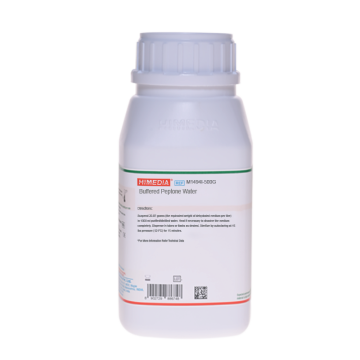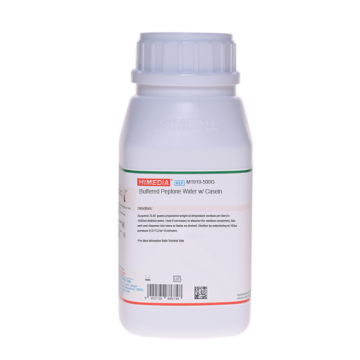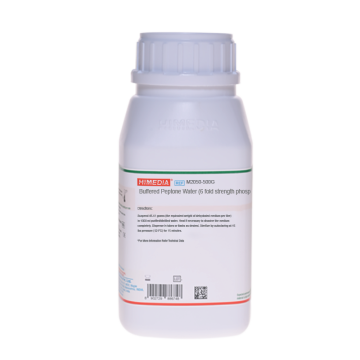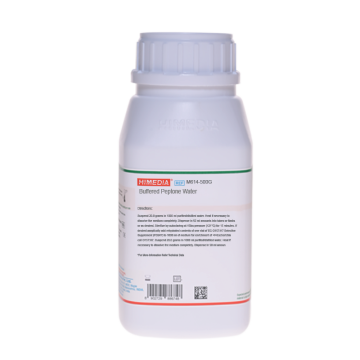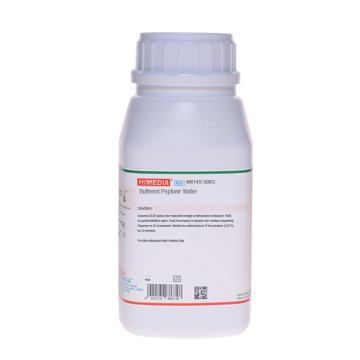 Your enquiry has been submitted
Your enquiry has been submitted
Universal Pre-enrichment Broth
Intended Use
Recommended for pre-enrichment of Salmonella from food products in accordance with FDA BAM, 1998. It can also be used for enriching Listeria species.
Composition**
| Ingredients | g/L |
|---|---|
| Tryptone | 5.000 |
| Proteose peptone | 5.000 |
| Potassium dihydrogen phosphate | 15.000 |
| Disodium hydrogen phosphate | 7.000 |
| Sodium chloride | 5.000 |
| Dextrose (Glucose) | 0.500 |
| Magnesium sulphate | 0.250 |
| Ferric ammonium citrate | 0.100 |
| Sodium pyruvate | 0.200 |
Final pH (at 25°C): 6.3±0.2
**Formula adjusted, standardized to suit performance parameters
Directions
Suspend 38.05 grams in 1000 ml purified/distilled water. Heat if necessary to dissolve the medium completely. Dispense into tubes or flasks as desired. Sterilize by autoclaving at 15 lbs pressure (121°C) for 15 minutes.
Principle And Interpretation
Environmental stress induces sublethal injury or metabolic damage to microbial cells. Recovery of such damaged microbial cells is achieved by growth in a non-selective media prior to isolation on selective media (1). Injury may result from many food processing and handling methods, including thermal treatment, refrigeration, freezing, drying and irradiation or from exposure to preservatives, acidity or low water activity. Universal Pre-enrichment Broth, formulated by Bailey and Cox (2), is different from the other enrichment broths that either contains antibiotics or are not sufficiently buffered to support injured bacteria (3,4). This medium is recommended by APHA and FDA BAM (1,5). This medium is sufficiently buffered to support growth of injured bacteria. Tryptone and proteose peptone serve as sources of carbon, nitrogen, vitamins and minerals. Dextrose serves as the source of energy. Phosphates buffer the medium. Magnesium sulphate, sodium chloride and ferric ammonium citrate provide essential ions required for metabolism. Sodium pyruvate stimulates the metabolism of injured organisms.
Type of specimen
Food samples.
Specimen Collection and Handling:
For food samples, follow appropriate techniques for sample collection and processing as per guidelines (1,5). After use, contaminated materials must be sterilized by autoclaving before discarding.
Warning and Precautions :
Read the label before opening the container. Wear protective gloves/protective clothing/eye protection/face protection. Follow good microbiological lab practices while handling specimens and culture. Standard precautions as per established guidelines should be followed while handling specimens. Safety guidelines may be referred in individual safety data sheets.
Limitations :
- Isolation should be carried on general purpose and selective media. Further biochemical and serological tests must be carried out for further identification.
Performance and Evaluation
Performance of the medium is expected when used as per the direction on the label within the expiry period when stored at recommended temperature.
Quality Control
Appearance Light yellow to beige homogeneous free flowing powder
Colour and Clarity of prepared medium Light amber coloured clear to slightly opalescent solution that may have a slight precipitate
Reaction Reaction of 3.8% w/v aqueous solution at 25°C. pH : 6.3±0.2
pH 6.10-6.50
Cultural Response Cultural characteristics observed after an incubation at 35-37°C for 18-24hours.
| Organism | Inoculum (CFU) | Growth |
|---|---|---|
| Listeria monocytogenes ATCC 19118 | 50-100 | good |
| Salmonella Enteritidis ATCC 13076 (00030*) | 50-100 | good |
| Salmonella Typhimurium ATCC 14028 (00031*) | 50-100 | good |
Key: *Corresponding WDCM numbers.
Storage and Shelf Life
Store between 10-30°C in a tightly closed container and the prepared medium at 15-30°C. Use before expiry date on the label. On opening, product should be properly stored dry, after tightly capping the bottle in order to prevent lump formation due to the hygroscopic nature of the product. Improper storage of the product may lead to lump formation. Store in dry ventilated area protected from extremes of temperature and sources of ignition. Seal the container tightly after use. Product performance is best if used within stated expiry period.
Disposal
User must ensure safe disposal by autoclaving and/or incineration of used or unusable preparations of this product. Follow established laboratory procedures in disposing of infectious materials and material that comes into contact with sample must be decontaminated and disposed of in accordance with current laboratory techniques (6,7).
Reference
- Salfinger Y., and Tortorello M.L. Fifth (Ed.), 2015, Compendium of Methods for the Microbiological Examination of Foods, 5th Ed., American Public Health Association, Washington, D.C.
- Bailey J. S., and Cox N. A., 1992, J. Food Prot. 55:256-259.
- Bailey J. S., Fletcher D. L. and Cox N. A., 1990, J. Food Prot., 53:473-477.
- Juven B. J., Cox N. A., Bailey J. S., Thomson J. E., Charles O. W., and Shutze J. V., 1984, J. Food Prot., 47: 299-302.
- FDA US.Bacteriological Analytical Manual. 8 ed. Gaithersburg, Md. : AOAC International; 1998.
- Isenberg, H.D. Clinical Microbiology Procedures Handbook 2nd Edition.
- Jorgensen, J.H., Pfaller, M.A., Carroll, K.C., Funke, G., Landry, M.L., Richter, S.S and Warnock., D.W. (2015) Manual of Clinical Microbiology, 11th Edition. Vol. 1.
| Product Name | Universal Pre-enrichment Broth |
|---|---|
| SKU | M1372 |
| Product Type | Regular |
| Physical Form | Powder |
| Origin | Animal |
| Packaging type | HDPE |
| References | 1. Downes F. P. and Ito K., (Ed.), 2001, Compendium of Methods for the Microbiological Examination of Foods, 4th Ed.,American Public Health Association, Washington, D.C. |
| Customized Product Available | No |




